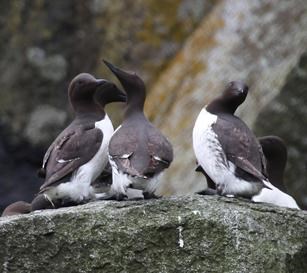
NPS Photo / K. White Uria aalge(Common murre)Uria lomvia(Thick-billed murre)Basic InfoThe murre is the largest member of the Alcid family, web-footed diving birds with short legs and wings that includes birds such as auklets, guillemots, murres, murrelets, and puffins. Visitors often mistake murres for loons. Their shape and coloring is similar, but a loon is much larger. The murre's stance and coloring closely resembles a penguin: their feet sit far back on their body giving them a distinct upright posture. Two species of murre reside in the park: the common murre and the thick-billed murre. We see the common murre most frequently, usually at close range along the edge of nesting sites on rocky cliffs. The common murre is dark brown, appearing black, on its head, back, and wings. They have white undersides and a thin white stripe on the back edge of their folded wing. A faint brown streaking appears on their flanks. Their sharp, slender bill is often pointed upwards. The common murre weighs just over two pounds and is 17.5 inches long with a wingspan up to 26 inches. The thick-billed murre, which is rare in the park, is more robust than the common, with a heavier head and neck. The most identifiable field mark is a white stripe extending down its cheeks from the bill. The back of the thick-billed murre appears blacker than that of the common and there is little or no brown streaking on the flanks. The thick-billed murre weighs just over two pounds and is 18 inches long with a wingspan of 28 inches. Habitat, Range and Local SightingsThe murre's range is circumpolar from 36 to 75 degrees north. In the Pacific Ocean, murres breed from Northern California to the Bering Sea. Common murres are abundant in the Gulf of Alaska. Murres spend their winters at sea over the continental shelf and just south of the pack ice in the Bering Sea. Common and thick-billed murres nest together throughout their range. The thick-billed murre predominates from the Aleutians northward. The common murre is more abundant in Resurrection Bay than in the fjords. The south side of Cape Resurrection has birds nesting on many ledges and in caves. Barwell Island is the most populated common murre nesting site in our area. In the early season, look for "great rivers of murres" flowing out beyond Barwell across the ocean surface. In May and June, one can often see "wheeling" of murres above Barwell. Wheeling is a defensive flight pattern practiced by the birds to keep them safe from bald eagles and peregrine falcons. Common murres are found closer to the town of Seward in small numbers on the water south of Caines Head. They have numerous small nesting colonies throughout the Chiswell Islands. Thick-billed murres may be seen, but they are rare in our area. Food and Survival StrategiesMurres are mid-water feeders. The deepest diving of all alcids, they can reach depths of 600 feet and swallow their prey under water. In Alaska, the common murre feeds at the trophic level of some marine mammals consuming such things as pollock, sculpin, flounder, and capelin. Gulls have been known to prey on murre chicks. The dense colonial nesting habit of the murres helps to protect their young from terrestrial and aerial predation. Reproduction and YoungMurres nest in dense colonies on sheer cliff ledges, standing side by side and often touching each other. This dense nesting habit protects murres and their chicks from gulls, ravens, eagles and other predators. Murres use no nesting material. Murres begin breeding at five to six years of age and lay a single pyramidal egg. Designed for life on a ledge, the pear-shaped egg does not roll when jostled but spins around the smaller end. Egg color varies from greenish to pinkish, with patterns of mottling making each egg distinct. This is important with such close, undefined nesting quarters. Males and females take shifts of 14-17 hours incubating their egg over a 33-day period. Upon hatching, both parents feed the chick for about 20 to 25 days, after which the female flies off. The male parent stays on to care for the chick. When the chick fledges, its male parent leaves with it, spending up to two months with the chick. Human ConnectionsMurres act as an indicator species for researchers. They nest in such large numbers that a change in food availability results in rafts of dead murres washing ashore. Recent research shows that, feeding toward the top of the food chain, murres accumulate toxins in the way of many local marine mammals. Murre eggshells gathered on remote islands in the Bering Sea contained elevated levels of persistent organic pollutants. Alaska Natives collect murre eggs for food. In the 1990s, an average household on St. Lawrence Island consumed 60-104 murre eggs each year. Murres were heavily impacted by the Exxon Valdez oil spill. The population in the spill area declined about 40 percent, however the birds appear to have recovered to pre-spill levels. |
Last updated: May 20, 2025
